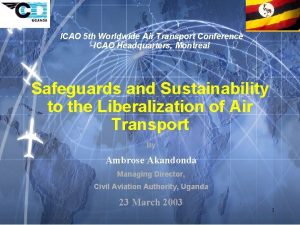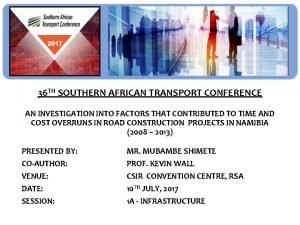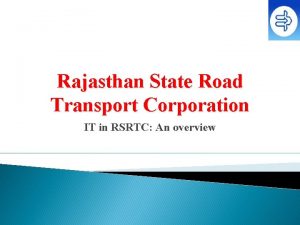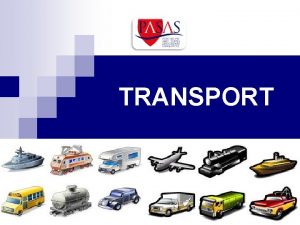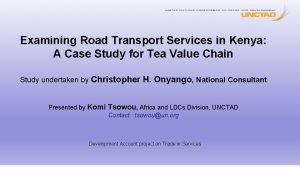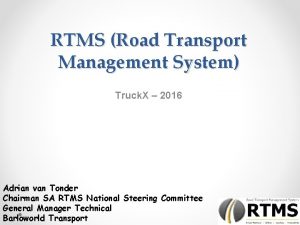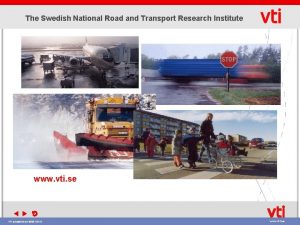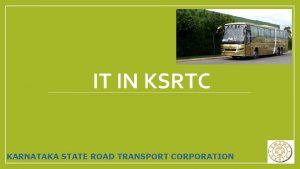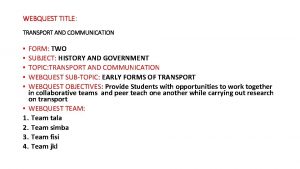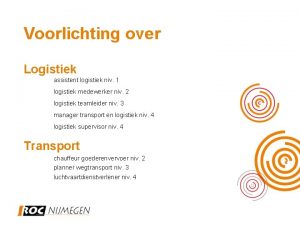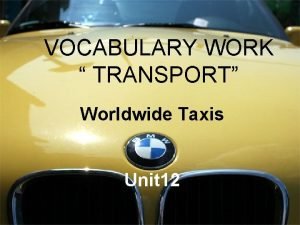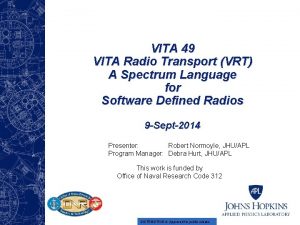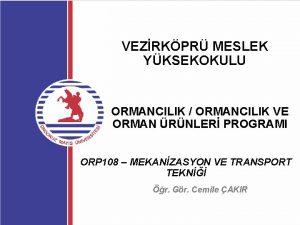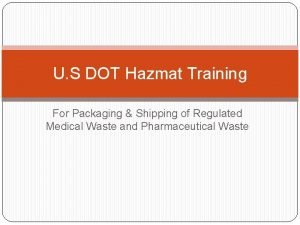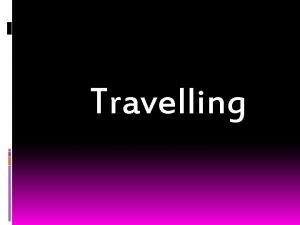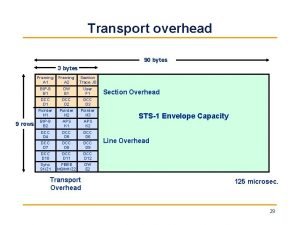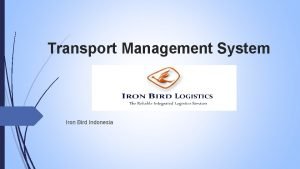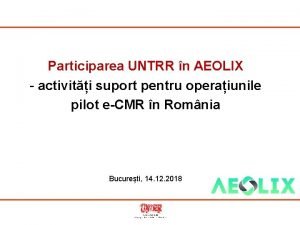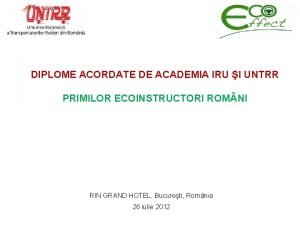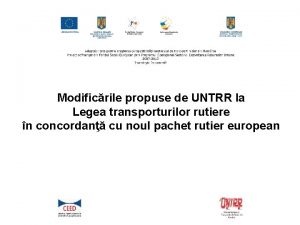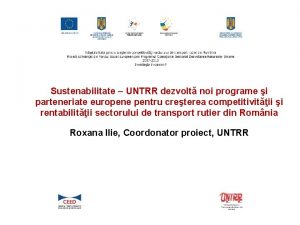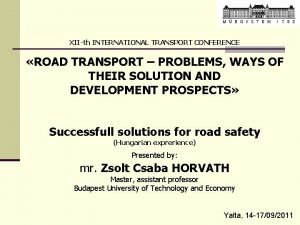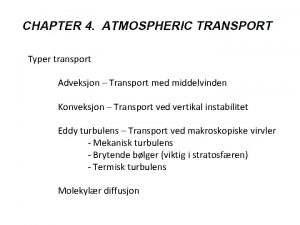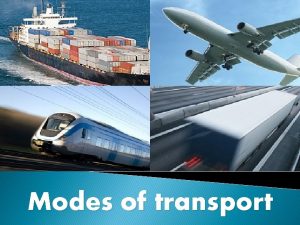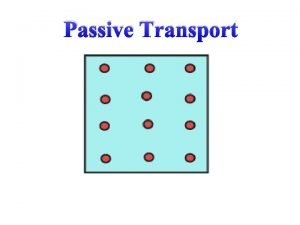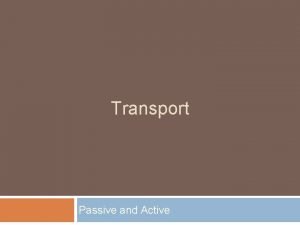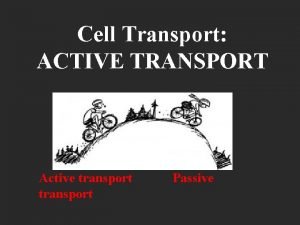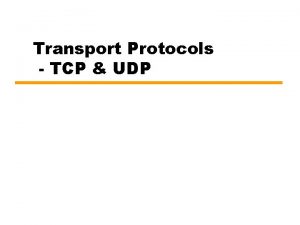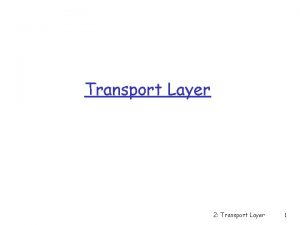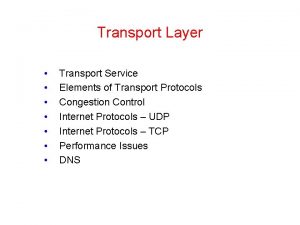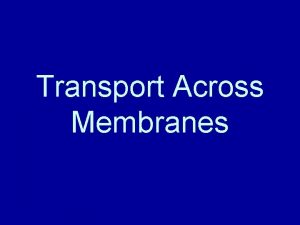EU Road Transport Strategy UNTRR Conference on road













































- Slides: 45

EU Road Transport Strategy UNTRR Conference on road package 21 September 2017 Mobility and Transport

Outline 1. General presentation of the mobility package 2. Fair and competitive mobility 3. Clean and sustainable mobility 4. Connected mobility Mobility and Transport

General presentation of the mobility package Mobility and Transport

Main challenges • Impact on the environment and climate • Road sector responsible for almost a quarter of Europe's greenhouse gas emissions • A source of high external costs (pollution, noise, congestion) • Protection of rights of workers and Fair competition • Avoid fragmentation of the internal market • Promote EU solutions rather than uncoordinated national measures • Avoid unnecessary administrative burdens for road hauliers Mobility and Transport

Main objectives of the road initiatives • Simplify/clarify existing rules (e. g. rules on cabotage) • Ensure rights of workers and fair competition, while preserving the internal market (e. g. specific rules on posting of workers) • Contribute to Paris Agreement and the 2030 goals by reducing CO 2 & external costs (e. g. differentiate tolls based on CO 2) • Ensure compliance with EU law (e. g. digital tachograph, exchange of information between enforcement authorities) • Promote digital solutions for tolling and adapt to emerging possibilities provided by ITS Mobility and Transport

From preparation to adoption… • The preparation – an inclusive process : • Detailed studies – 5 impact assessments - 7 legislative proposals • Intense consultative process to define the problems and test solutions: Member States, associations, road hauliers, drivers • Conferences, seminars, etc. • Adoption of the proposals on 31 May – and then ? • Programme of the Estonian Presidency • Programme of the TRAN committee • Objective: try to conclude before EP elections June 2019 Mobility and Transport

Fair and competitive mobility Internal market Mobility and Transport

1. Letterbox companies THE SITUATION TODAY • Certain hauliers open "fake subsidiaries" in low wage Member States: to exploit wage differentials, while operating in some cases exclusively in high wage Member States. For example: Jost Group hiring drivers in Slovakia through letterbox companies; € 55 million in unpaid social contributions in Belgium. • Consequences: unfair competitive advantage over hauliers which are properly established in Member States where they operate. Cost advantage of a letterbox company amounts to 30% of the company's costs. Mobility and Transport

1. Letterbox companies THE COMMISSION PROPOSAL • Further criteria on establishment: to ensure that haulier has real activity in Member State of establishment. Firms must conduct business from premises in Member State; must hold assets and employ staff proportionate to activity; must keep commercial and labour contracts in premises. • Cooperation between Member States: Member States are obliged to cooperate with each other to uncover letterbox companies: reply within 25 working days; on-site inspections if needed. Mobility and Transport

2. Cabotage THE SITUATION TODAY • Market subject to restrictions: mainly due to wage cost differentials. "3 in 7 rule". • Restrictions are very difficult to enforce: paper documents are required by control authorities. Number of cabotage operations cannot be checked. • Member States do not enforce cabotage rules consistently: some have specific controls, others don't control at all. • Consequences: illegal cabotage, unfair competition in national markets, mistrust between national and foreign operators. Mobility and Transport

2. Cabotage THE COMMISSION PROPOSAL • New rule: Unlimited cabotage within 5 days of international carriage. • Electronic documents: obligation for Member States to accept electronic documents as proof of legality of cabotage (e. g. e. CMR). • Minimum checks for Member States: 2% from 1/1/2020 and 3% from 1/1/2022; Member States to report to Commission. Mobility and Transport

3. Light goods vehicles (LCVs) THE SITUATION TODAY • Presence of LCVs is growing: Growth of e-commerce, etc. Also in international transport. No tachograph, no need to comply with social rules, not subject to rules on access to profession/market. • Consequences: Operators using LCVs subject to different (less stringent) rules when competing with operators using heavy goods vehicles; some MS apply their own rules on access to profession to LCV operators. Mobility and Transport

3. Light goods vehicles (LCVs) THE COMMISSION PROPOSAL • Access to profession: LCV operators subject to 2 criteria – establishment and financial standing (€ 1, 800 for first vehicle, € 900 for each additional one). • Reporting obligations: yearly reporting obligations for Member States; Commission to report to EP and Council by end 2024. Mobility and Transport

4. Hired vehicles THE SITUATION TODAY • "Own account" operators prevented from using hired vehicles above 6 tons (i. e. operators carrying their own goods) : 4 Member States apply such restrictions. • Prohibition to use vehicles hired (and registered) in another Member State : About half of the Member States apply such a restriction / require immediate re-registration of the vehicle in their country. • Consequences : Patchwork of rules, legal uncertainty for operators, operators cannot benefit from advantages of using hired vehicles (e. g. flexibility in the management of their fleet of vehicles). Mobility and Transport

4. Hired vehicles THE COMMISSION PROPOSAL • Removal of the restriction on use of hired vehicles for "own account" operations. • New rule for the use of vehicles hired (and registered) in another Member State : Member States obliged to allow the use for at least 4 months in a calendar year. • Objective : allow operators to use vehicles hired abroad to meet seasonal/temporary demand peaks or to replace damaged vehicles. • Justification of the limit of 4 months : prevent operators from flagging out their fleet to low-tax countries. Mobility and Transport

Fair and competitive mobility Social rules Mobility and Transport

1. Weekly rest - today • Rigid rule on weekly rest requirements : drivers in international transport often unable to reach home in time for weekly rests, have to stop and rest e. g. 20 km from home. • Place where the weekly rest should be taken : national measures prohibiting regular weekly rest in the vehicle (France, Belgium and Germany). • Consequences: unequal treatment of drivers and operators due to differences between Member States in the application of weekly rest provisions; drivers' long periods away from home; violations of the rules. Mobility and Transport

1. Weekly rest - proposal • Flexibility in distribution of weekly rest : 2 regular (45 h) and 2 reduced (24 h) weekly rest periods a month; drivers should be able to return home 1 x / three weeks. • Regular weekly rest in adequate accommodation : provided by employer or taken at home. • Benefits: • For drivers : easier to reach home for regular weekly rest and take compensation for reduced weekly rest; improved resting conditions. • For operators : efficient planning of transport operations and coping with unforeseen circumstances. Mobility and Transport

2. Enforcement - today • Poor administrative cooperation between Member States : inconsistent implementation and enforcement of EU rules. • Differences between national risk rating systems : hindering information exchange and effective checks. • Poor enforcement of working time rules • Consequences: unequal treatment of drivers and operators; inconsistent, inefficient and ineffective enforcement; violations of the rules, distortions of competition. Mobility and Transport

2. Enforcement - proposal • Fixed deadlines for exchange of information and data between Member States • Uniformula for risk rating of undertakings • Access for control officers to national risk rating systems • Recording country code in tachograph after crossing border • Uniform checks on working time • Benefits: consistent and effective cross-border enforcement, equal treatment of drivers and operators. Mobility and Transport

3. Posting of workers - today • Provisions on posting of workers not adapted for highly mobile road transport sector : drivers are present in Member States for sometimes very short periods of time. • National measures on the application of the minimum wage: France, Germany, Austria, and Italy adopted national rules on a minimum wage. • Different administrative and control requirements imposed on non-resident operators • Consequences: restrictions to freedom of provision of services; disproportionate regulatory burdens for non-resident operators – ca 1, 4 billion/year administrative costs. Mobility and Transport

3. Posting of workers - proposal • International transport operations : time threshold of 3 cumulated days per month in host Member State for the application of the minimum wage and annual paid leave rights of the host State. • Cabotage : no threshold. Application of the minimum wage and annual paid leave rights from the 1 st operation. • Lighter administrative and control requirements: Member States cannot require representative in host State, simpler and fewer notifications, no pay slips needed on board vehicle. • Easier controls of driver's presence in host State : modification of the tachograph regulation. • Benefits: uniform sector-specific rules on posting; reduced administrative costs by 58%; benefits for (EU-13) drivers due to higher remuneration. Mobility and Transport

4. Working time - today • Long reference period (4 -6 months) for calculating average maximum weekly working time of 48 h : result is long hours worked (60 h) over several consecutive weeks. • No uniform requirements for monitoring working hours • Impossible to control working time at roadside checks • Consequences: differences in enforcement, violation of working time limits; accumulated fatigue of drivers, risks to road safety. Mobility and Transport

4. Working time – future proposal • Consultation of social partners launched on direction of possible revision of working time rules. • Options for possible future proposal : reduce reference period for calculating weekly working time to 4 weeks • Benefits of possible EU action: reduced accumulated fatigue, easier checks at roadside. Mobility and Transport

Clean and sustainable mobility Road charging Mobility and Transport

1. Vehicles THE SITUATION TODAY • Only HGVs above 3, 5 t and possibility to exempt HGVs below 12 t – No rules for other vehicles (buses, coaches, private cars). • Consequence: discrimination against foreign nationals – lack of proportionality between annual and short term vignettes; compensation between vignettes and taxes. Mobility and Transport

1. Vehicles THE COMMISSION PROPOSAL • Extend scope to all HGVs, bus/coach, van, minibus, passenger car: Bus and coach cause same damage as trucks – same charging rules as HGVs. • Light vehicles: proportionality of time-based charges Availability of short-term vignettes at proportionate price: o 10 -days: max 8% of annual AND o Monthly: max 18% of annual OR o Bi-monthly: max. 30% of annual • Compensation with reduction of taxes: only in case of introducing distance-based charges. Mobility and Transport

2. Tolls, vignettes and vehicle tax THE SITUATION TODAY • Choice between vignettes and tolls for HGV's : o Tolls are proportionate and can be modulated according to environmental performance; o Time-based vignettes are only remote proxy, ineffective in covering infrastructure costs or addressing pollution; they often raise issues of discrimination. • Minimum vehicle tax for HGVs > 12 t • No rules for other vehicles • Consequence: Various systems in place in the EU, inconsistent pricing. Mobility and Transport

2. Tolls, vignettes and vehicle tax THE COMMISSION PROPOSAL • Decision to have charging remains for MS but time based charges to be phased out – only distance-based charges allowed: o For HGVs and bus/coach: by 2023 Ø coupled with gradual reduction of the min. vehicle tax for HGVs > 12 t o For LDVs (van, minibus, passenger car): by 2027 Mobility and Transport

3. Variation of charges – environmental performance THE SITUATION TODAY • Mandatory variation based on Euro emission class (air pollutants): becoming obsolete because more and more trucks are EURO VI; prevents the use of a more appropriate instrument – external cost charging. • External cost charging: Optional, with complex calculation methods, notification requirement. • Consequence: Only two Member States apply external cost charging (Germany and Austria). • No rule for cars and vans: they are responsible for the bulk of air pollution and CO 2 emissions in road transport, representing at least 1 % of GDP. Mobility and Transport

3. Variation of charges – environmental performance THE COMMISSION PROPOSAL • EURO class differentiation: to be phased out by 2021 • HGVs and bus/coaches – New revenue neutral variation based on CO 2: as soon as CO 2 emission certification data become available (~ 2020). • LDV's – Variation based on CO 2 and real-driving pollutant emissions • Zero-emission vehicles: 75% lower than highest rate. • Simplified application of external cost charges (pollution and noise): o no need to notify and calculate: updated reference values o notification required only if MS wants to apply higher charges than reference. Mobility and Transport

4. Fighting congestion THE SITUATION TODAY • Congestion costs over 1% of GDP to society: at least 2030% of this is interurban congestion. • Revenue neutral variation of charge to address congestion: Suboptimal and unfair if only applied to HGVs, uninteresting and too cumbersome for Member States. • Consequence: Only a handful of Member States use it on a limited number of motorway stretches. • Mark-ups (15 – 25 %) limited to mountainous regions. Mobility and Transport

4. Fighting congestion THE COMMISSION PROPOSAL • • Optional congestion charging on top of the infrastructure charge • To be applied to all vehicles • Maximum amounts set to avoid overcharging • Only on regularly congested stretches and congested hours • Reinvest revenues in transport Extension of the mountainous areas possibility to Mobility and Transport use mark-ups also outside

5. Investment in infrastructure • Earmarking of revenues: o From mark-ups and congestion charging • Reporting: o Each year (instead of every four years) o For all schemes (not only where infra or external cost charge is levied) o Include clearer info on use of revenues o Evaluation of infrastructure maintenance based on indicators (surface, safety, congestion) o Evaluation of congestion on tolled roads o COM to adopt harmonised indicators (implementing act) Mobility and Transport

Connected Mobility European Electronic Toll Service (EETS) Mobility and Transport

0. Two legislative acts • Recast of the interoperability Directive 2004/52/EC • Co-decision • General framework conditions for the operation of e-tolling systems • New elements: • cross-border enforcement; • More flexibility on technology to facilitate EETS and technological progress; • Revision of the EETS Decision 2009/750/EC • PRAC • Precise definition of the EETS and its technical elements • New elements: • Removal of market entry barriers; • More/fairer competition; • Removal of excessive requirements Mobility and Transport

1. Cross-border enforcement THE SITUATION TODAY • No effective instruments in place to identify the owners of a foreign-registered vehicles: Member States cannot identify toll offenders on the basis of the plate number registered by automatic enforcement gantries. • Consequences: • Those who evade payments can escape fines. This leads to a revenue leakage of ca. € 300 million/year; • Where offenses are due to a human or technical error, users don’t know that they accumulate fines until they are stopped and presented with extremely high bills Mobility and Transport

1. Cross-border enforcement THE COMMISSION PROPOSAL • Automatic mechanism for the exchange, between Member States, of information on the identity of the owners or holders of vehicles for which a toll is suspected of not having been paid: with this information, Member States will be able to follow up cases of tolls not paid by non-resident drivers. • Simple system of exchange of information : To reduce costs and administrative burden, the mechanism used will be the same as for the exchange of information on road-safety-related traffic offences Mobility and Transport

2. Technology THE SITUATION TODAY • Video tolling systems (e. g. London/Stockholm congestion charge) are not covered by the legislation: users must register themselves into the system and process payments • EETS providers must serve light vehicles with complex and expensive satellite on-board units even though it is not necessary • The legislation contains a rigid list of technologies allowed for use in the electronic toll collection Mobility and Transport

2. Technology THE COMMISSION PROPOSAL • The scope of application is extended to video tolling systems: users will have one counterpart (the EETS provider) to pay any electronic toll, whatever the technology applied. • EETS allowed, until 2027, to serve cars with simple and cheap On Board Units (OBUs). • List of technologies moved to the Annex of the Directive : to allow updating by the Commission (delegated act) depending on technological developments. Mobility and Transport

3. Access to market for EETS service providers THE SITUATION TODAY • Each EETS provider obliged to cover all electronic toll domains (ca. 150) in the EU: this comes at high cost, ultimately paid by the users, most of which do not need full EU-coverage. • Unfair competition between EETS providers and incumbent toll service providers: certain Member States discriminate against EETS providers by offering them worse conditions than those enjoyed by incumbents (low remuneration, limited access to technical specifications of the system, etc. ). Mobility and Transport

3. Access to market for EETS service providers THE COMMISSION PROPOSAL • EETS providers free to choose their market coverage, but must inform users thereof in a transparent manner. • Principle of non-discrimination, rights of EETS providers and obligations of toll chargers clearly defined in the legislation: notably right of EETS providers to fair remuneration, right to be accredited to a new system before its operational launch, obligation for toll chargers of transparency towards EETS providers, etc. Mobility and Transport

4. Digital enforcement THE SITUATION TODAY • Road transport is currently very much compared to other modes of transport paper-based • Varying levels and effectiveness of controls between Member States • Lack of structured cooperation and risk rating between Member States Mobility and Transport

4. Digital enforcement THE COMMISSION PROPOSAL • Provide for the possibility to use e-documents (e. g. e-CMR) • Further exploit tachograph : (1) oblige drivers to record in which countries and how long they are staying; (2) launch study to assess how to accelerate the implementation for the SMART tachograph • Improve risk rating via ERRU (European Register for Road Undertakings) to enable targeted checks • Cooperation between Member States via rules on exchange of information Mobility and Transport

Thank you Mobility and Transport
 Uniport symport antiport
Uniport symport antiport Primary active transport and secondary active transport
Primary active transport and secondary active transport Now answer the questions
Now answer the questions Passive transport vs active transport venn diagram
Passive transport vs active transport venn diagram Unlike passive transport, active transport requires
Unlike passive transport, active transport requires Primary active transport vs secondary active transport
Primary active transport vs secondary active transport Bioflix activity membrane transport active transport
Bioflix activity membrane transport active transport Active transport diagram
Active transport diagram Bioflix activity membrane transport diffusion
Bioflix activity membrane transport diffusion Air transport conference
Air transport conference Southern african transport conference
Southern african transport conference South african transport conference
South african transport conference Rsrtc smart card online apply
Rsrtc smart card online apply Advantage and disadvantage of road transport
Advantage and disadvantage of road transport Transport services in kenya
Transport services in kenya Road transport management system
Road transport management system Swedish national road and transport research institute
Swedish national road and transport research institute Ksrtc online leave management
Ksrtc online leave management What is paved and unpaved road
What is paved and unpaved road Corporate strategy and business strategy
Corporate strategy and business strategy Multi domestic strategy
Multi domestic strategy Chase demand example
Chase demand example Multidomestic strategy vs transnational strategy
Multidomestic strategy vs transnational strategy Aligning hr strategy with business strategy
Aligning hr strategy with business strategy Integration responsiveness grid
Integration responsiveness grid The managerial process of crafting and executing strategy
The managerial process of crafting and executing strategy Strategy formulation and implementation
Strategy formulation and implementation What is listening strategies
What is listening strategies Captive company strategy
Captive company strategy International or multinational
International or multinational How is water transported in humans
How is water transported in humans History of water transportation
History of water transportation Manager transport en logistiek bol
Manager transport en logistiek bol Unit 12 transport
Unit 12 transport Transport verbs
Transport verbs Vita 49 standard
Vita 49 standard Mekanizasyon ve transport tekniği
Mekanizasyon ve transport tekniği Www.mystericycle.com login
Www.mystericycle.com login Active vs passive transport
Active vs passive transport Regulation of tubular reabsorption
Regulation of tubular reabsorption What is your favourite mode of transport
What is your favourite mode of transport Transport triggered architecture
Transport triggered architecture Transport overhead
Transport overhead Passive transport ex
Passive transport ex Les conventions du transport maritime
Les conventions du transport maritime Iron bird transport
Iron bird transport









